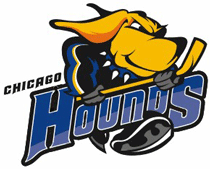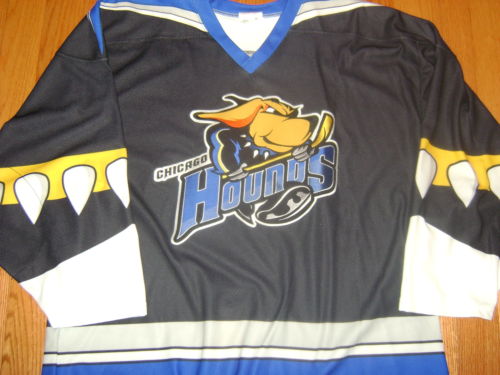United Hockey League (2006-2007)
Tombstone
Born: 2006 – UHL expansion franchise
Folded: June 2007
First Game: October 14, 2006 (W 4-3 @ Rockford IceHogs)
Last Game: April 19, 2007 (L 4-2 vs. Fort Wayne Komets)
UHL Championships: None
Arena
Sears Centre
Opened: 2006
Marketing
Team Colors:
Ownership
Owners:
- 2006-2007: Dr. Eric Margenau
- 2007: Craig Drecktrah
Background
The Chicago Hounds were a One-Year Wonder in the minor United Hockey League during the winter of 2006-07. The club was part of a stable of marginal minor sports franchises that signed on as anchor tenants for the new $62 million Sears Centre in suburban Hoffman Estates, Illinois, located 25 miles northwest of Chicago. The Hounds would compete for winter dates with the Chicago Shamrox box lacrosse team of the National Lacrosse League and the Chicago Storm, who played in the latest incarnation of the Major Indoor Soccer League. The 11,000 Sears Centre also signed on a spring/summer tenant with the Chicago Slaughter of the beyond-obscure Continental Indoor Football League.
New York-based sports psychologist Dr. Eric Margenau owned both the Hounds and the Slaughter franchises through his Chicagoland Sports subsidiary. Margenau was an experienced sports investor and consultant, starting with minor league baseball investments in the 1980’s and later branching out to minor league hockey and Arena Football through his United Sports Ventures outfit. The Hounds took their name and identity from Margenau’s late golden retriever Mikey, who died shortly before Margenau purchased the UHL expansion franchise in early 2006.
Opening Night Meltdown
The Sears Centre opened on October 26th, 2006 with a Duran Duran concert and Bob Dylan performed the following night. The arena operator – the Minnesota-based Ryan Cos., which developed the property – had no previous experience managing buildings. That lack of experience would haunt the Hounds one week later at the team’s inaugural home game.
The 4,000+ curious fans who turned out for Hounds opening night on November 3rd, 2006 were greeted by the site of hockey boards with no safety glass in them. As an ad hoc team of arena workers and ushers struggled to install the slabs of plexiglass, another brigade stood on what passed for the ice surface, which arena management had failed to recondition after a figure skating exhibition the previous night. A Zamboni operator drove endless and entirely fruitless laps around the rink. A small team of men doused center ice with a garden hose and tried to flash freeze it with blasts from a fire extinguisher.
After nearly two hours of high comedy, the ice remained hopelessly unplayable. United Hockey League Commissioner Richard Brosal took the ice to announce the game’s cancellation to the remaining crowd. Brosal was pelted with Hounds’ souvenir pucks as the would-be fans angrily filed out of the building.
Sale & Closure
And really, what else is there to say about the Hounds? To the extent they are remembered by anyone, it’s for that first game that never was. The relationship between Chicagoland Sports and the Sears Centre never recovered. In February, a Hounds home game drew only 500 fans to the building. The team averaged fewer than 1,500 overall. In early March 2007, only three months into the Hounds’ first season, Margenau abruptly sold off the Hounds and Chicago Slaughter indoor football team to separate new investors. Sears Centre Executive Director Steve Hyman took some shots at Margenau in the press on his way out of town:
“There’s no way to be diplomatic about this…they did a deplorable job,” Hyman told The Chicago Daily Herald in March 2007, “They didn’t spend a dime to promote or market their product and it showed.”
Now this may or may not be true. Stories of extreme thriftiness on the part of Margenau and the teams he operates are not new. Exhibit A: check out Fun While It Lasted’s account of the Margenau/United Sports Ventures ownership of minor league baseball’s Peninsula Pilots when the team rained out games for lack of a tarp in the 1980’s. Then again … it was Hyman’s own staff that couldn’t lay down a proper sheet of ice for opening night. So perhaps his public critiques of Margenau should be taken with a grain of salt.
New Hounds owner Craig Drecktrah folded the club in June 2007 only three months after buying the team from Margenau. Drecktrah cited Sears Centre officials, who wanted to triple the team’s lease payments and offered primarily weeknight dates in return, as the key factor in his decision to mothball the franchise.
The Chicago Hounds finished their only season 31-38-7. They lost in the first round of the 1997 UHL playoffs.
Aftermath
The Sears Centre bled money under Ryan Cos. operation and ownership from 2007 to 2009. The building lost a reported $10.8 million in 2007 alone and another $5.1 million in 2009. In late 2009, Ryan Cos. abandoned the property and handed it back to the village of Hoffman Estates, who brought in the experienced Global Spectrum venue management company.
The franchises brought into fill dates at the building fared little better. In addition to the Hounds’ rapid demise, the Chicago Shamrox lacrosse team lasted only two seasons. Former Shamrox General Manager Phil Ryan estimated the box lacrosse team lost an astounding $6 million to $7 million during that time. The Chicago Storm indoor soccer team moved out in 2009 to play in youth soccer training center.
Former Hounds owner Craig Drecktrah was awarded an ECHL expansion franchise for Chicago to begin play in the 2011-12 season. His Chicago Express debuted at the Sears Centre in the autumn of 2011.
Links
###



3 Responses
Interesting! One minor correction: The Slaughter have survived and play/played at the Sears Centre in between the Hounds and Express. They also “moved up” from the CIFL to the Indoor Football League.
Craig was also a part owner of the UHL era Rockford Icehogs.
The Sears Centre, presently called NOW Arena has been mismanaged from the day it opened. It’s the Arena where franchises go to die. You absolutely cannot have minor league entertainment and believe you can charge major league prices for parking, concessions and amenities. This is exactly what Arena management did and turn potential fans into haters.
This place could absolutely be home to minor league hockey. There isn’t a bad seat in the house. There are a million people within a 15 mile radius of the arena, it can work.